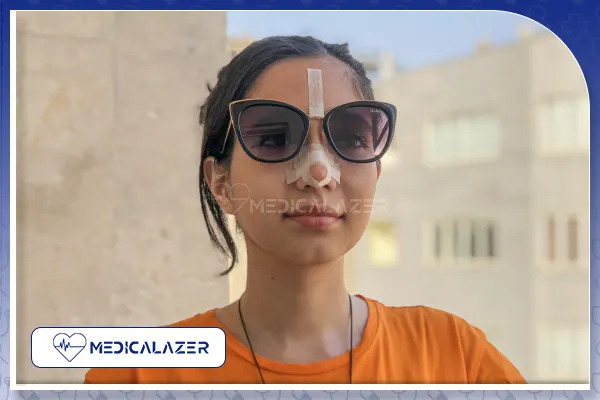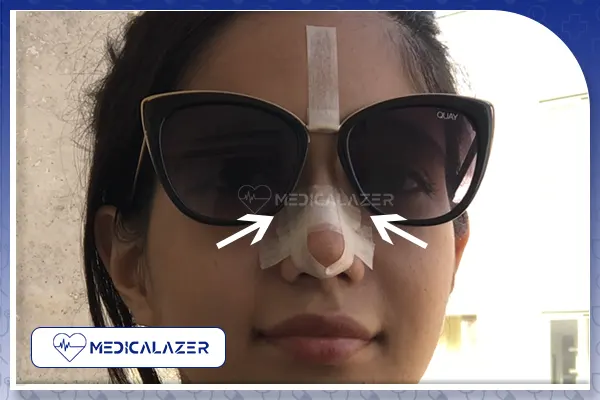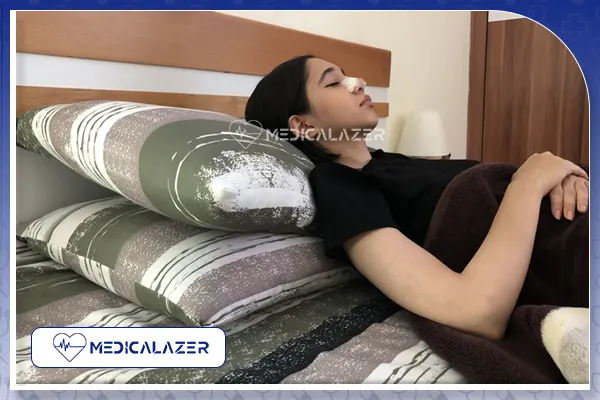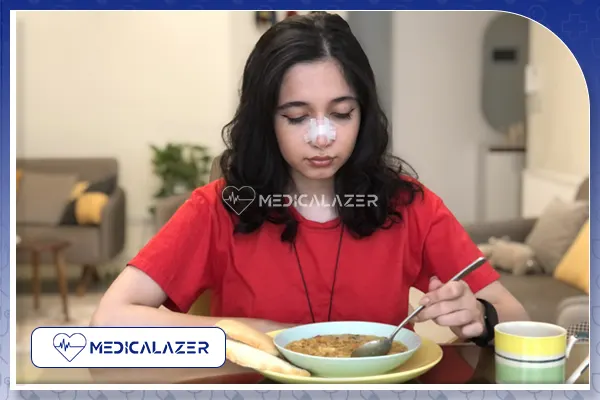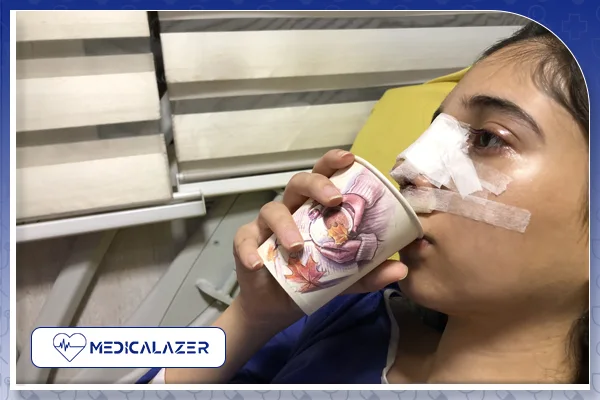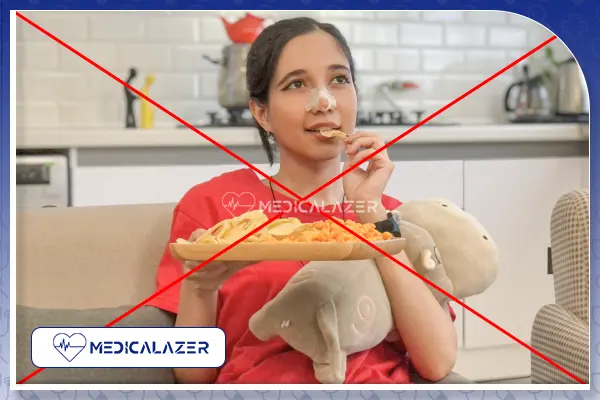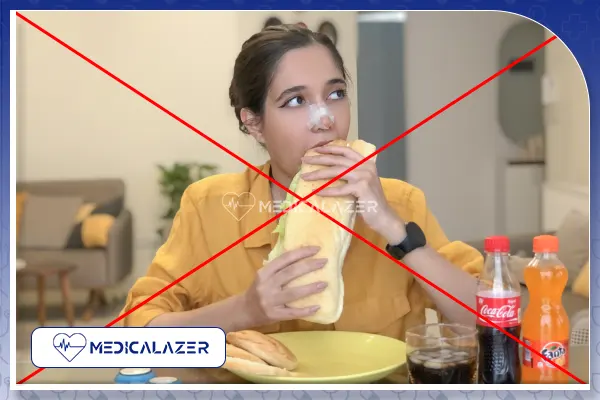Undergoing rhinoplasty, commonly known as a nose job, can be a life-changing experience for many individuals seeking to enhance their facial features. However, it is not uncommon for patients to notice asymmetrical swelling after this procedure, many patients ask: why one side of my nose is more swollen after rhinoplasty? In this article, we will explore the reasons behind uneven swelling, and provide insights into its duration, common concerns, and potential solutions.
What are the causes of uneven swelling after rhinoplasty?
After rhinoplasty, swelling is an expected part of the healing process. While initial swelling typically subsides within the first few weeks, some patients may experience persistent or uneven swelling that extends beyond the expected timeframe. This phenomenon can be attributed to various factors as follows:
Individual Healing Patterns
Each person’s body responds differently to surgery and the healing process. Some individuals may naturally have more pronounced swelling or slower lymphatic drainage, leading to uneven swelling. Inflammation is a natural part of the healing process. However, some individuals may have a more robust or prolonged inflammatory response, which can contribute to uneven swelling.
Surgical Technique
The surgical technique used during rhinoplasty can contribute to uneven swelling. If adjustments were made on one side of the nose more extensively than the other, it can result in asymmetrical swelling during the healing process.
Tissue Trauma
Rhinoplasty involves manipulating and reshaping nasal tissues. This surgical trauma can cause localized inflammation and swelling. If the trauma is more pronounced on one side of the nose, it can lead to uneven swelling.
Postoperative Care
Following proper postoperative care instructions is essential for optimal healing. Failure to follow guidelines such as avoiding excessive physical activity, protecting the nose from trauma, Incorrect taping of the nose and sleeping on one side can potentially contribute to uneven swelling. You can find more about each one’s details below:
1- Incorrect taping:
Incorrect taping of the nose can potentially contribute to uneven swelling. Incorrect taping of the nose after rhinoplasty can potentially contribute to uneven swelling. Taping is often used as part of the postoperative care regimen to support the nasal tissues, control swelling, and aid in proper healing. However, if the taping is done improperly, it can result in asymmetrical pressure distribution and subsequently uneven swelling. Here’s how incorrect taping can lead to this issue:
- Uneven Compression: Taping is typically applied to provide gentle compression and support to the nasal tissues. If the tape is applied too tightly or unevenly, it can create excessive pressure on certain areas of the nose while leaving others with insufficient compression. This uneven compression can disrupt lymphatic drainage and blood flow, leading to uneven swelling.
- Taping Technique: The technique used to apply the tape is crucial in ensuring proper pressure distribution. If the tape is not applied evenly across the nose or if it is applied in a way that pulls or distorts the nasal tissues, it can cause localized swelling and asymmetry.
- Adhesive Allergies or Irritation: Some individuals may be allergic or sensitive to the adhesive used in the tape. If an allergic reaction or irritation occurs, it can lead to increased inflammation and swelling on one side of the nose, resulting in uneven swelling.
- Tape Removal: Improper removal of the tape can also contribute to uneven swelling. If the tape is removed forcefully or incorrectly, it can cause trauma to the delicate nasal tissues, leading to localized swelling and asymmetry.
To minimize the risk of uneven swelling due to incorrect taping, it is crucial to follow the specific instructions provided by your surgeon. They will guide you on the appropriate taping technique, the duration of the tape application, and how to remove the tape properly. Additionally, if you experience any discomfort, irritation, or excessive swelling related to the tape, it is important to inform your surgeon for appropriate guidance and adjustments.
2- Sleeping on one side:
Sleeping on one side after rhinoplasty can potentially contribute to uneven swelling due to several reasons:
- Increased Fluid Accumulation: When you sleep on one side, gravity can cause an accumulation of fluid and blood in the lower side of the face, including the nose. This can result in increased swelling on that side, leading to an imbalance in the healing process.
- Pressure and Compression: Sleeping on one side can exert pressure and compression on the nasal tissues. This can hinder proper blood circulation and impede the healing process, causing increased swelling and potential asymmetry.
- Disruption of Healing Structures: After rhinoplasty, delicate nasal structures undergo a healing process. Sleeping on one side can potentially put pressure on these structures, such as the nasal bones or cartilage, which can lead to displacement or distortion. This can contribute to uneven swelling and alter the overall appearance of the nose.
To minimize the risk of uneven swelling, it is recommended to sleep on your back with an elevated head for at least one month after nose surgery. This sleeping position promotes proper circulation, reduces fluid accumulation, and helps maintain a more balanced healing process. Following your surgeon’s instructions regarding sleeping positions and postoperative care can significantly contribute to achieving optimal results and reducing the chances of asymmetrical swelling.
Addressing Uneven Swelling: Tips and Solutions
- Patience and Time: Uneven swelling after rhinoplasty can be distressing, but it is crucial to remember that the healing process varies from person to person. Patience is key, as it can take up to a year or longer for the swelling to completely resolve and for the final results to become apparent.
- Avoiding Excessive Physical Activity: Engaging in strenuous activities or exercises that increase blood flow can exacerbate swelling. It is advisable to follow your surgeon’s guidelines and refrain from vigorous activities until you have received clearance.
- Gentle Massage Techniques: With your surgeon’s approval, gentle massage techniques can help improve lymphatic drainage and reduce swelling. However, it is essential to follow your surgeon’s instructions and avoid applying excessive pressure, as it could disrupt the delicate healing process.
- Regular Follow-ups and Communication: Maintaining regular follow-up appointments with your surgeon is vital. They will monitor your healing progress and address any concerns you may have about uneven swelling. Open communication allows your surgeon to provide reassurance and guidance throughout the recovery period.
- Cold Compresses and Elevation: Applying cold compresses to the swollen areas, especially in the early stages, can help minimize swelling. Additionally, keeping your head elevated while resting can help reduce fluid accumulation and promote proper circulation.
- Avoiding Excessive Physical Activity: Engaging in strenuous activities or exercises that increase blood flow can exacerbate swelling. It is advisable to follow your surgeon’s guidelines and refrain from vigorous activities until you have received clearance.
- Managing Emotional Distress: Uneven swelling can cause emotional distress, as it may affect self-esteem and body image. It is crucial to seek emotional support from loved ones and consider professional counseling if necessary.
How long does uneven swelling last after rhinoplasty?
Uneven swelling after rhinoplasty typically resolves gradually over time as the healing process progresses. The exact duration for complete resolution of uneven swelling can vary from person to person and depends on various factors, including the individual’s healing capacity, the extent of the surgical procedure, and the specific techniques employed.
In general, most patients can expect the majority of the swelling to subside within the first few weeks to months following rhinoplasty. However, it’s important to note that residual swelling, albeit minimal, can persist for several months or even up to a year.
The initial significant reduction in swelling occurs during the first few weeks post-surgery. By the 3-month mark, a substantial portion of the swelling typically subsides, leading to noticeable improvements in the overall appearance of the nose. However, it’s common for some degree of residual swelling to persist, particularly in areas such as the tip of the nose, for several months.
By the 6-month milestone, the majority of patients experience a significant reduction in swelling, with the nose gradually taking on its final shape. However, it’s essential to note that minor fluctuations in swelling may still occur during this period. Complete resolution of uneven swelling can take up to a year or even longer in some cases, especially if the surgery involved complex adjustments or if the patient has thicker nasal skin. It’s crucial to maintain realistic expectations and understand that the healing process is unique to each individual.
Frequently asked questions:
1- Why does my nose look crooked after rhinoplasty swelling?
Some people after rhinoplasty ask why is one side of my nose more swollen than the other? The uneven distribution of swelling during the early stages of healing can create the illusion of a crooked nose. In some cases, the pre-existing anatomy of the nose, such as deviated septum or asymmetrical cartilage, can contribute to a crooked appearance. While efforts are made during rhinoplasty to correct these issues, achieving perfect symmetry may be challenging due to the inherent characteristics of the individual’s nose.
2- Does rhinoplasty heal unevenly?
Rhinoplasty healing can vary from person to person, and in some cases, it may result in uneven healing. It’s important to note that while some degree of asymmetry or uneven healing may be observed during the early stages of recovery, the majority of cases tend to improve with time as the tissues heal and swelling subsides.
 Medicalazer Online Health and Beauty Magazine
Medicalazer Online Health and Beauty Magazine
